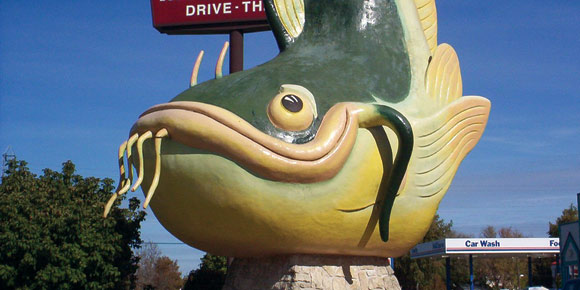For many people, a weekend at the cottage includes driving up Highway 9 to the Interlake. Along the way you will see three structures that you won’t find anywhere else in the world.
Mallard Duck
Petersfield, Manitoba
The idea to erect a giant duck statue in Petersfield, Manitoba came about in early 1990s. A mallard was chosen as the species was a familiar site in the community due to its proximity to Netley Marsh and because it graced the local curling club’s crest.
By September 1994, the Petersfield Duck Monument Association was in full swing, hosting a design contest and fundraising events. It was co-chaired by area residents Elva Juba, widow of former Winnipeg Mayor Steven Juba, and local bylaw enforcement officer “Curly” Gagnon.
The committee visited other communities with large roadside monuments to get ideas and to gather the names of artists that worked on projects of that scale. They eventually selected St. Andrews-based Wayne Arthur as their artist of choice
Arthur was born and raised in Ontario and trained as an illustrator. He moved to Manitoba in 1967.
It wasn’t until the early 1980s that Arthur rediscovered a childhood passion for sculpting. By the time Petersfield came calling, his body of large-scale works included the fibreglass “King Buck” monument at Poplarfield, the four-metre-tall limestone “Caring Hands” at Deer Lodge Centre and the stone Aboriginal hunting scene at the Forks National Historic Site.
Thanks to strong community support, the fundraising campaign was finished a couple of years earlier than expected. In July 1995, Gagnon told the Selkirk Journal that $32,000 had been raised, enough to place an order with the artist.
Due to his busy schedule, Arthur spent over a year working on the mallard in his workshop. It involved building a steel skeleton over which many layers of fibreglass were laid. The duck is 4.2 metres tall with a wingspan of 7.3 metres. It stands atop a 3-metre cairn.
As for the location, Donahoe Farms donated a two-acre piece of land off Highway 9 at the foot of the Netley Creek Bridge for a new park in which the monument would be the focal point.
The Petersfield Mallard Duck was installed in late 1996. In 2005, it was rededicated to celebrate the 100th anniversary of the community.
Chuck the Channel Cat
Selkirk, Manitoba
The Red River near Selkirk, Manitoba has always been known as a hotspot for catching catfish. In the mid 1980s the city decided to cash in on this reputation.
It began in 1985 when the area’s economic development body, then known as Triple S, registered a variety of slogans proclaiming Selkirk as the Catfish Capital of Manitoba, Canada, North America, the world, and even the universe. They also announced the construction of an 11-metre-tall catfish statue for the city.
Triple S put up $10,000 and the city of Selkirk followed in January 1996 with $13,200 of its own. Later that month, the group commissioned Arnes, Manitoba artist Harold Moore to produce the work.
A Winnipeg native, Moore moved to the Interlake in 1973. His medium is varied but what attracted the committee at the time was his fibreglass work. This included his signature sculpted heads and the production of mannequins, dozens of which appear across the country in Parks Canada historic displays.
With the artist busy at work, attention turned to finding a name and location for the statue.
The winning entry in a “name the catfish” contest was Chuck the Channel Cat, a nod to local fisherman Chuck Norquay.
Norquay did much to promote catfishing in Selkirk, even bringing it to the attention of Babe Winkleman and earning himself and the city a spot on the famous fisherman’s syndicated U. S. television show. Sadly, the sport Norquay loved took his life when he drowned in the Red River in 1993 at the age of 38.
Finding a location for the catfish proved controversial. After weeks of debate the city chose a spot in Selkirk Park but people were unhappy. Many felt it would be too hidden and noted that Chuck would be inaccessible in winter when the park was closed. The city reversed its decision.
The finished statue sat in a warehouse for weeks while the location debate continued. Finally, a lease was signed with a Main Street businessman for its current location and the statue was unveiled on May 23, 1986.
Gimli Viking
Gimli, Manitoba
In 1965, the Gimli Chamber of Commerce came up with the idea of erecting a giant Viking statue as their community’s Canadian centennial project.
They approached University of Manitoba School of Art professor Gissur Eliasson to research Viking culture and draw up what he felt were historically appropriate images of a Viking. The drawings were then turned over the artist Giorgio Barone to turn them into reality.
Barone came to Winnipeg from his native Italy in 1949 and worked for a time as a set designer with the CBC. In the mid-1960s he pioneered a way of creating large, nearly indestructible fibreglass figures using foam, wire mesh and a varnish that included marble dust.
There are few parts of the province that do not have a Barone statue. His works include the Thompson Miner, Transcona’s Hi Neighbour Sam, McCreary’s Alpine Charlie and the Boissevain Turtle.
The 4.5-metre-tall, $15,000 statue was unveiled near the original Betel Home at Second Avenue and First Street South on July 30, 1967. The guest of honour was Iceland’s president, Asgeir Asgeirson.
In 1985, Betel Home announced expansion plans and the Viking had to find a new home. In 1989, it was moved about 35 metres to its present location. In 2017, an elaborate “Viking Park” was built around the statue.
Christian Cassidy writes about local history on his blog, West End Dumplings.



